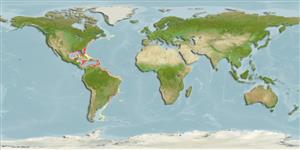Elasmobranchii (sharks and rays) >
Rajiformes (Skates and rays) >
Rajidae (Skates)
Etymology: Dactylobatus: Greek, daktyleys, -eos = a kind of grey mullet + Greek, batis = a kind of ray (Ref. 45335).
Environment: milieu / climate zone / depth range / distribution range
Ecology
Marine; bathydemersal; depth range 475 - 1000 m (Ref. 28767). Deep-water; 5°S - 31°N, 97°W - 33°W (Ref. 114953)
Western Central Atlantic: northern Gulf of Mexico (Ref. 13608) to South Carolina (Ref. 114953) and northern coast of South America (Ref. 5217).
Size / Weight / Age
Maturity: Lm ? range ? - ? cm
Max length : 59.0 cm TL male/unsexed; (Ref. 13608); 69.0 cm WD (female)
Inhabits mud-bottom habitat on the upper slope, generally in waters deeper than 350 meters. Mainly feeds on small bony fishes (Ref. 114953). Stomach contents include one specimen of Mullus argentinae, remains of a teleost fish and predominance of Myctophidae fishes. Sympatric with other chondrichthyans, Etmopterus bigelowi, Squalus aff. blainvillei, and Dipturus leptocauda (Ref. 56543). Oviparous (Ref. 50449). Eggs have horn-like projections on the shell (Ref. 205).
Life cycle and mating behavior
Maturities | Reproduction | Spawnings | Egg(s) | Fecundities | Larvae
Oviparous, paired eggs are laid. Embryos feed solely on yolk (Ref. 50449). Eggs have horn-like projections on the shell (Ref. 205).
McEachran, J.D. and K.A. Dunn, 1998. Phylogenetic analysis of skates, a morphologically conservative clade of elasmobranchs (Chondrichthyes: Rajidae). Copeia 1998(2):271-290. (Ref. 27314)
IUCN Red List Status (Ref. 130435)
Threat to humans
Harmless
Human uses
Tools
Special reports
Download XML
Internet sources
Estimates based on models
Preferred temperature (Ref.
123201): 5.5 - 13, mean 8 °C (based on 76 cells).
Phylogenetic diversity index (Ref.
82804): PD
50 = 0.7500 [Uniqueness, from 0.5 = low to 2.0 = high].
Bayesian length-weight: a=0.00302 (0.00141 - 0.00645), b=3.24 (3.07 - 3.41), in cm total length, based on LWR estimates for this (Sub)family-body shape (Ref.
93245).
Trophic level (Ref.
69278): 4.5 ±0.80 se; based on food items.
Resilience (Ref.
120179): Low, minimum population doubling time 4.5 - 14 years (Fec assumed to be <100).
Fishing Vulnerability (Ref.
59153): Low vulnerability (22 of 100).
